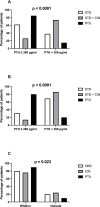Parathyroidectomy: still the best choice for the management of severe secondary hyperparathyroidism
- PMID: 38039492
- PMCID: PMC11210536
- DOI: 10.1590/2175-8239-JBN-2023-0024en
Parathyroidectomy: still the best choice for the management of severe secondary hyperparathyroidism
Abstract
Introduction: Management of secondary hyperparathyroidism (SHPT) is a challenging endeavor with several factors contruibuting to treatment failure. Calcimimetic therapy has revolutionized the management of SHPT, leading to changes in indications and appropriate timing of parathyroidectomy (PTX) around the world.
Methods: We compared response rates to clinical vs. surgical approaches to SHPT in patients on maintenance dialysis (CKD 5D) and in kidney transplant patients (Ktx). A retrospective analysis of the one-year follow-up findings was carried out. CKD 5D patients were divided into 3 groups according to treatment strategy: parathyroidectomy, clinical management without cinacalcet (named standard - STD) and with cinacalcet (STD + CIN). Ktx patients were divided into 3 groups: PTX, CIN (cinacalcet use), and observation (OBS).
Results: In CKD 5D we found a significant parathormone (PTH) decrease in all groups. Despite all groups had a higher PTH at baseline, we identified a more pronounced reduction in the PTX group. Regarding severe SHPT, the difference among groups was evidently wider: 31%, 14% and 80% of STD, STD + CIN, and PTX groups reached adequate PTH levels, respectively (p<0.0001). Concerning the Ktx population, although the difference was not so impressive, a higher rate of success in the PTX group was also observed.
Conclusion: PTX still seems to be the best treatment choice for SHPT, especially in patients with prolonged diseases in unresourceful scenarios.
Introdução:: O manejo do hiperparat-ireoidismo secundário (HPTS) é uma tarefa desafiadora com diversos fatores que contribuem para o fracasso do tratamento. A terapia calcimimética revolucionou o manejo do HPTS, levando a alterações nas indicações e no momento apropriado da paratireoidectomia (PTX) em todo o mundo.
Métodos:: Comparamos taxas de resposta às abordagens clínica vs. cirúrgica do HPTS em pacientes em diálise de manutenção (DRC 5D) e pacientes transplantados renais (TxR). Foi realizada uma análise retrospectiva dos achados de um ano de acompanhamento. Pacientes com DRC 5D foram divididos em 3 grupos de acordo com a estratégia de tratamento: paratireoidectomia, manejo clínico sem cinacalcete (denominado padrão - P) e com cinacalcete (P + CIN). Os pacientes com TxR foram divididos em 3 grupos: PTX, CIN (uso de cinacalcete) e observação (OBS).
Resultados:: Na DRC 5D, encontramos uma redução significativa do paratormônio (PTH) em todos os grupos. Apesar de todos os grupos apresentarem um PTH mais elevado no início do estudo, identificamos uma redução mais acentuada no grupo PTX. Com relação ao HPTS grave, a diferença entre os grupos foi evidentemente maior: 31%, 14% e 80% dos grupos P, P + CIN e PTX atingiram níveis adequados de PTH, respectivamente (p< 0,0001). Com relação à população TxR, embora a diferença não tenha sido tão impressionante, também foi observada uma taxa maior de sucesso no grupo PTX.
Conclusão:: A PTX ainda parece ser a melhor escolha de tratamento para o HPTS, especialmente em pacientes com doenças prolongadas em cenários sem recursos.
Conflict of interest statement
Figures


References
-
- Kidney Disease: Improving Global Outcomes (KDIGO) CKD-MBD Update Work Group. CKDMBDUWG. KDIGO 2017 Clinical Practice Guideline Update for the Diagnosis, Evaluation, Prevention, and Treatment of Chronic Kidney Disease-Mineral and Bone Disorder (CKD-MBD). Kidney Int Suppl (2011). 2017 Jul;7(1):1–59. doi: 10.1016/j.kisu.2017.04.001. - DOI - PMC - PubMed
MeSH terms
Substances
LinkOut - more resources
Full Text Sources
Medical
Research Materials

